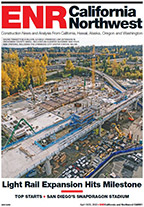New construction starts in April advanced 11% to a seasonally adjusted annual rate of $531.3 billion, according to McGraw-Hill Construction, a division of The McGraw-Hill Cos.
The increase for April followed a 23% gain in March, as contracting soared well above its lackluster pace at the outset of 2012. Much of the lift in March came from work at a nuclear power facility in Georgia, and a similar lift was provided in April by work at a nuclear power facility in South Carolina.
Aside from the strength shown by electric utilities, April drew support from an improved amount of public works construction and a sizeable upturn for nonresidential building after a weak March. Also contributing to April’s gain for total construction was a slight increase for residential building. During the first four months of 2012, total construction on an unadjusted basis came in at $138.2 billion, up 4% from the same period a year ago.
The latest month’s data raised the Dodge Index to 112 (2000=100), compared to 102 for March. Both April and March were considerably above the full year 2011 average for the Dodge Index at 91, as well as above the depressed readings for the Index in January (85) and February (83).
The April construction start statistics included $8.5 billion for work at the Virgil C. Summer nuclear power facility near Jenkinsville, S.C. In late March, the U.S. Nuclear Regulatory Commission approved a combined construction and operating license for Units 2 and 3, enabling construction work to begin on the two nuclear reactors. This follows more than $1.0 billion related to site work at the Summer facility, which had been entered into the construction start statistics during 2011.
If both the Vogtle nuclear power facility in Georgia (entered as a March 2012 start) and the Summer nuclear power facility are excluded from the March and April statistics, respectively, then total construction starts in March would be down 3% followed by a 13% increase in April. The pace of total construction starts for April without the Summer nuclear facility would be $429.3 billion (annual rate), producing a reading of 91 for the Dodge Index, the same as the average monthly pace for total construction in 2011.
“Aside from the boost coming from this year’s nuclear power projects, the picture for construction starts in early 2012 is one of deterioration though March followed by some improvement in April,” stated Robert A. Murray, vice president of economic affairs for McGraw-Hill Construction. “The overall level of activity continues to hover within a set range and has not yet shifted from a hesitant up-and-down pattern to more steady expansion. On a positive note, nonresidential building in April was able to bounce back, suggesting that this sector’s current status is not quite as weak as portrayed in February and March.”
Non-building Construction
Non-building construction in April advanced 15% to $245.6 billion (annual rate). The electric utility category was able to climb 9% on top of its exceptional March rate, as work at the Summer nuclear power facility in South Carolina matched the lift coming in March from the Vogtle nuclear power facility in Georgia.
In addition, April included the start of other large electric utility projects – a $1.1-billion natural gas-fired power plant in Virginia, a $668-million waste-to-energy facility in Florida, a $375-million wind farm in Illinois, and two wind farms in Pennsylvania valued at $220 million and $210 million.
For public works construction, the miscellaneous public works category (which includes mass transit) jumped 106% in April, led by an $877-million segment of the Eagle P3 commuter rail project in the Denver area. The environmental public works categories in April registered large gains, after their weak activity earlier in 2012. River/harbor development climbed 35%, helped by a $99-million dredging project on the Mississippi River in New Orleans. Water supply construction jumped 26%, supported by a $242-million water tunnel project in New York City, and sewer construction grew 24%.
Essentially flat in April were highway construction, up only 2%, and bridge construction, down 1%. The April amount for highway and bridge construction was 10% below the average monthly pace for these project types during 2011.
Murray noted, “Highway and bridge construction continues to deal with diminished federal funding and the uncertainty created by the repeated short-term extensions of SAFETEA-LU, the multiyear transportation legislation that expired in 2009.”
Nonresidential Building


Post a comment to this article
Report Abusive Comment